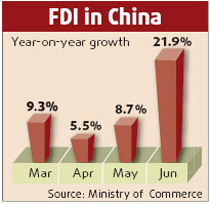Brisk exports, strong investment and buoyant consumption will lift economic growth in China to 11.2 percent this year, up from an earlier estimate of 10 percent, with the inflation rate breaking 4 percent, says an Asian Development Bank (ADB) report released here on Monday.
"The faster than expected growth momentum built up this year is expected to carry into 2008," Zhuang Jian, senior economist of ADB's China Resident Mission, at a press conference in Beijing.
The new ADB report also forecasts that China's GDP growth in 2008 will reach 10.8 percent, an upward revision from the 9.8 percent projection in March when ADB launched the flagship annual forecasting publication ADB 2007.
Zhuang said China's economy grew at a faster-than-expected 11.5 percent in the first half of 2007, which is the highest rate since 1994.
According to Zhuang, China's fast economic growth was led by industry, especially in such sectors as steel, electricity, chemicals, and oil processing.
Strong profitability, buoyant sales and still-low lending rates also drove investment during the period.
The ADB report said investment administered by local governments grew by 28.1 percent in the first six months, nearly doubling the equivalent central government rate. It suggests the efforts made by the central government to tighten local investment have not had lasting effects.
China's inflation barometer, the Consumer Price Index (CPI), is estimated to be 4.2 percent this year and 3.8 percent in 2008 against the previous forecasts of 1.8 percent and 2.2 percent, respectively, according to the ADB report.
Zhuang said rising global grain prices and the outbreak of blue ear pig disease led to sharply higher food prices, but this is expected to ease next year, paving the way for the implementation of planned reforms in the pricing of state-controlled sectors such as water, power and natural gas.
The ADB report also forecasts that China's exports are forecast to grow by 20 percent and imports by 16 percent in the second half of 2007, resulting in a full-year trade surplus of around US$300 billion, up more than 60 percent from 2006.
China's exports rose by 27.6 percent in the first half, exceeding imports growth of 18.2 percent, lifting the trade surplus to US$112.5 billion.
Zhuang said the growth rate of some exports could slow in the second half due to some macro-control policies. From June 1, an export tariff was imposed on 142 products, while export tax rebates were reduced or abolished in July for 2,831 items.
The aim is to rein back the growing trade surplus and at the same time ease strains on the environment by reducing goods production that requires high inputs of energy and natural resources, and that causes high levels of pollution, said Zhuang.
Persistently high trade surpluses and capital inflows have further boosted foreign exchange reserves, complicating monetary policy. The ADB report said China's current account surplus is expected to swell to 10.9 percent of GDP this year and 10.5 percent in 2008, revised up from the 8.8 percent and 8.9 percent projected earlier this year.
The gap between export and import growth will probably narrow slightly as the changes to export tariffs and export tax rebates take effect, said Zhuang.
The ADB reports forecasts that China will face three major challenges in the future economic growth.
One is the higher than expected inflation, which poses a risk to the outlook. Zhuang said adverse weather would lower domestic grain production at a time when imported grain prices are high.
The other challenge is that the excessive liquidity in the financial system and relatively unattractive bank deposit rates helped boost stock and property prices. Zhuang said a major adjustment in stock prices could hurt bank balance sheets, and faced with rising non-performing loan ratios, banks would likely curtail lending with knock-on effects on the broader economy.
In addition, the key challenge for China is to reduce the country's reliance on exports and investment for growth in favor of private consumption.
"Such a switch could lessen vulnerability to external shocks and ease environmental strains caused by the emphasis on export and investment-led heavy industry." said Zhuang.
(Xinhua News Agency September 17, 2007)


